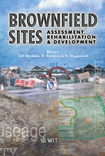The I-BO (TM) Process And Related Treatments For Mine Waste Remediation
Price
Free (open access)
Transaction
Volume
55
Pages
Published
2002
Size
733 kb
Paper DOI
10.2495/BF020521
Copyright
WIT Press
Author(s)
K. McEwan & D. Ralph
Abstract
The i-BOTM process and related treatments for mine waste remediation K. McEwan1 & D. Ralph2 1 Micron Research Pty. Ltd, Australia 2 Division of Science, Murdoch University Australia Abstract Acid mine drainage is an ongoing problem associated primarily with sulphidic mine wastes. Remediation of the mine sites is expensive. Micron Research Pty Ltd has developed the i-BOTM Process for treatment of a particularly difficult to remediate tailings dumps located near Tennant Creek in the Northern Territory of Australia. Application of the i-BOTM Process to the tailings darns results in an increase of the rate of natural weathering and hence acid production. Years of weathering are condensed into months allowing the acid drainage to be controlled and collected. The contained gold, cobalt and copper are then available to downstream metallurgical recovery processes making the remediation process profitable. 1 Introduction Centuries of mining and metallurgical treatment of ore bodies have left a legacy of billions of tonnes of tailings and low-grade waste. The sulphur contained in tailings is thermodynamically unstable and exposure to oxygen and water results in the oxidation of the sulphur containing minerals to sulphuric acid, generating acidic solutions that contain a cocktail of base metals and impurities. Hence, the remediation liability is exacerbated by seasonal parameters and natural oxidation of the exposed mineral, creating additional environmental problem in the form of acid and base metal drainage into the surrounding land, eventually polluting the waterways. The high cost of the remediation of mine sites frequently results in the liability being passed onto successive operators, or being ignored.
Keywords




